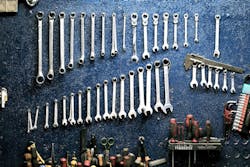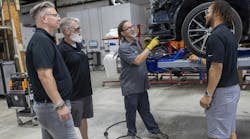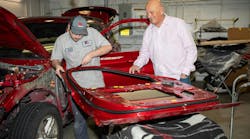SHOP STATS: Gullo Toyota Collision Center Location: Conroe, Texas. Operator: Tony Gullo Sr. Average Monthly Car Count: 112-150 cars Staff Size: 15 Shop Size: 16,000 sq ft; Annual Revenue;$3.5 million
Gullo Toyota Collision Center was stuck. The team didn’t think outside of the town of Conroe, Texas, where it’s located. There, the shop was the small fish in a big pond. It competed against other Toyota dealerships making $1 million in monthly sales while it produced roughly $25,000 per month.
So when the team attended the prestigious Toyota Certified Collision Center of the Year award in 2008 in Las Vegas, manager Mike Cortez and his team thought there was no way their shop could compete against the 1,500 other Toyota, Scion and Lexus dealerships in North America.
And when the dealership came in fourth place? Well, the team was shocked.
"We didn’t even know we were in the running for the award,” he says. “So, I got my guys together and said, ‘Look, if we can get fourth place without knowing, imagine what we can do if we focus on achieving the award.’”
At the time, the shop didn’t even track CSI scores. It was a problem the shop essentially refused to deal with for years, but nearly clinching the title of Toyota Certified Collision Center of the Year was an eye-opening experience that motivated Cortez to make customer service a greater priority.
Cortez decided to take that moment as a sign to change processes. Now, the shop is ranked No. 20 for net profit across 480 Toyota shops in the U.S., and has even managed to nab the prestigious award three years in a row.
The Backstory
It may sound backward to not track CSI scores, and Cortez readily admits that it was.
In fact, he was still able to avoid surveying every customer even after Toyota required its shops to send a survey company its repair orders and surveys in 2002. Cortez chose not to send the outside company the repair orders with bad surveys.
Years later, Toyota mandated that shops allow the outside survey companies to access their data. Cortez was faced with the reality that his shop now needed to track these more diligently and needed a shift in overall attitude to get his team on board.
The Problem
Beyond not having a system in place, the team did not meet Toyota’s standard CSI score—the shop needed to reach at least a 95 percent on its customer service surveys to be eligible for the award.
“You know there is always going to be the 3–4 percent of customers that it is impossible to make happy,” Cortez says.
Still, Cortez knew that for a majority of the customers who were unhappy, he could find ways to turn it around. In order to do this, Cortez first had to identify areas the shop needed to track numbers and find what numbers the shop could improve upon.
Cortez eventually realized two processes were missing in his shop and slowing down the team’s scores: the team was not tracking its numbers and not performing well on CSI scores.
Also, the team needed a personal touch to the customer and employee interactions. The team needed a front-office person who made the customers feel comfortable when first stepping into the small shop.
Cortez was soon able to identify that if the CSI scores dropped below 95 percent, he needed to find out where the repair went wrong.
The Solution
Initially when Cortez started at the shop in 2002, he was reluctant for many years to adopt the process that Toyota required shops to hire an independent company to conduct customer service surveys. When he finally got on board with the idea, he was able to see where in the process customers were unhappy with service.
The team hired Customer Research Inc. to conduct the surveys and implement daily reduction meetings. Everyone meets in the mornings for roughly 30 minutes and has time to go over the surveys and fix the negative reviews.
As a result of studying those surveys, the team has implemented the following changes:
-
The first person the customers now meet is Karen Hammock, the office manager. She comes from a background as a teacher for a local elementary school and keeps pictures of her grandchildren on her desk. The photos help to open a conversation with customers and make them feel comfortable to share if they have kids or grandchildren.
“She’s inviting and she talks to the customer, takes time to calm them down,” Cortez says. “It has to do with someone showing sympathy and sincerity.”
Hammock will ask customers if they were hurt during the accident or if anybody else was hurt.
-
Cortez found an issue with his customers during the delivery process because the car was not being delivered with a full tank of gas. So the team started putting stickers on the car’s side mirrors to notify the customer that the vehicle had a full tank of gas.
-
Another area of improvement was making sure the customer was notified right away if the insurance company found additional physical damage on the vehicle. Cortez says the customer is happier when notified how long the delay will be.
It’s essential to take those few minutes and talk with everyone about what the customer’s initial repair concerns were, Cortez says.
-
Cortez also sent five body technicians and two painters out of a staff of 15 people to become Toyota trained and certified. Tony Gullo, owner of Gullo Automotive Group, insisted the team be sent to California for training despite it costing $6,000 per person. By sending the staff, employees that feel needed and qualified are more likely to be upbeat and happy in the workplace, ultimately treating the customers with a good attitude, Cortez says.
The Aftermath
Now, the shop’s CSI score is up to 97 percent. In 2009, just one year after implementing new processes, the team won Toyota Certified Collision Center of the Year.
Cortez and his team realized that it was important to track both negative and positive customer surveys in order to improve on quality of repairs.
Beginning in 2012, the shop won the Toyota Certified Collision Center Triple Crown Award three years in a row.
And the team further bumped up its customer service by getting into the community and meeting new people. By reverting to the shop’s original niche, the team found that using the small-town shop mentality to serve their customers with a personal touch brought about a higher CSI score.
Gullo has supported 40–70 families each year during the holidays. He gifts them roughly $500 and supplies each family a Christmas tree in December.
“I try to instill in my employees that we should treat our customers with a small-town feeling,” Cortez says.
The shop now often takes care of repeat customers by offering free jobs if the ticket is below $300.
"Then they’ll go back to their church or civic communities and spread the word,” he says.
The Takeaway
Cortez has learned that every interaction with a customer starts with fixing the shop culture.
He’s found that without a positive culture in the shop, team members won’t want to improve customer satisfaction scores or even track numbers.
In order to give the customer a positive experience, the staff culture needs to revolve around compassion for coworkers and a positive attitude, Cortez says.
Expert Advice: Take a Look From the Outside
—
Marion Miller has spent a year touring collision repair shops and helping the shops tweak their processes.
Miller, owner of Complete Marketing Resources, discovered most shops never stopped to look at their customer service from the customer’s perspective. Here are tips for shops to focus on what the customer is seeing.
1. Is the shop clean?
Take a look at the waiting room, the bathrooms and even the tiniest details, like the windows, she says. These items make or break the customer’s first impression of your shop.
2. Are you asking for reviews?
Make sure to ask every customer to review your service. Shops should ask customers that have asked for a special service or if they seem very appreciative of the service.
Say, “If you don’t mind, we really appreciate it if you’d give us a good review on our Google site.”
Another way to inquire after reviews is to leave a memo at the bottom of the customer’s invoice that asks the customer to leave a review. Then, link the shop’s Google site or website.
3. Can customers reach the shop at all times?
Too many shops either don’t have the capability for customers to leave voice messages after business hours or its voicemail box is full of other messages, Miller says.



